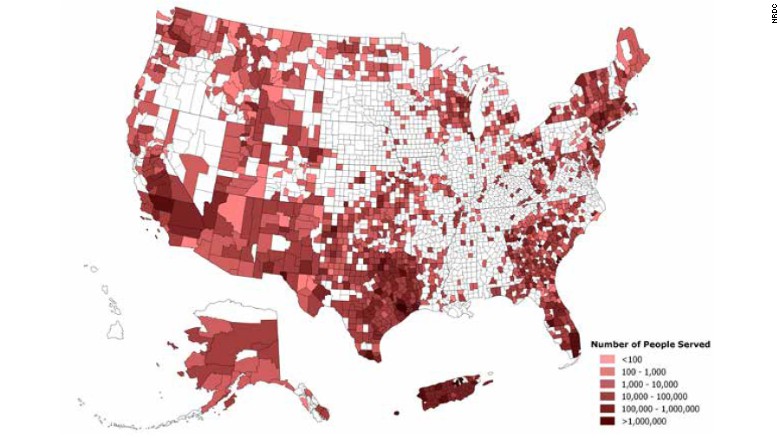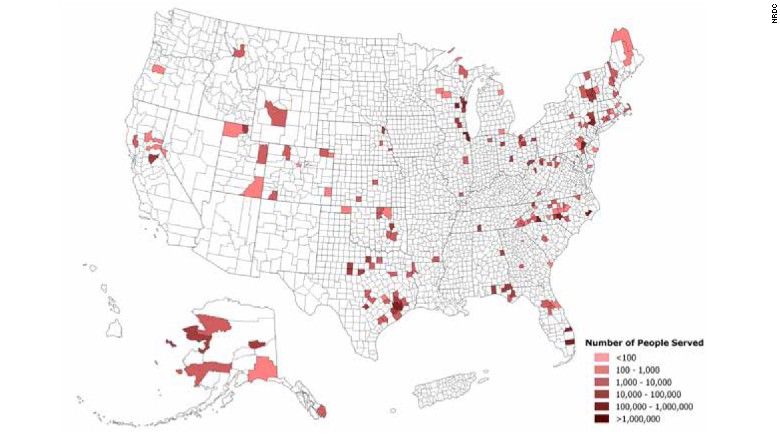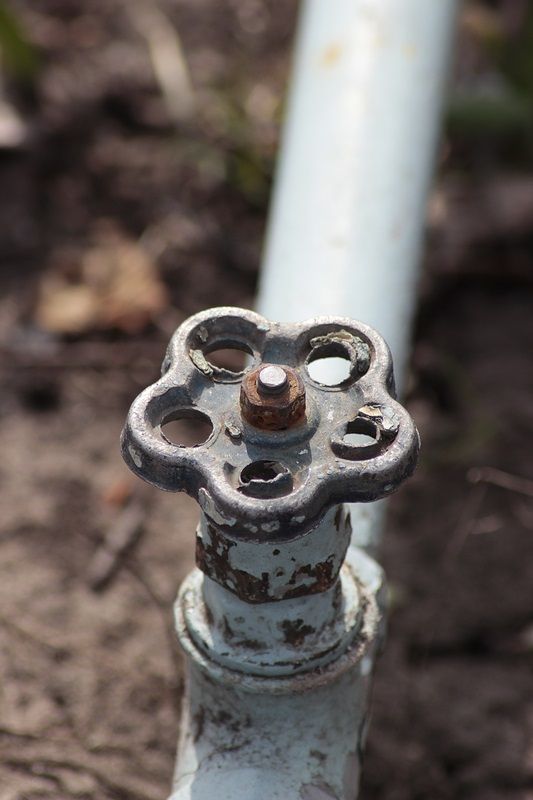5,300 U.S. water systems are in violation of lead rules
By Sara Ganim, CNN
Updated 6:50 AM ET, Wed June 29, 2016
More than 5,000 water systems in violation of rules
Story highlights
- 18 million Americans could be affected
- The EPA took action in just 88 cases
- Many utilities “game the system” with their testing methods
(CNN) Eighteen million Americans live in communities where the water systems are in violation of the law. Moreover, the federal agency in charge of making sure those systems are safe not only knows the issues exist, but it’s done very little to stop them, according to a new report and information provided to CNN by multiple sources and water experts.
“Imagine a cop sitting, watching people run stop signs, and speed at 90 miles per hour in small communities and still doing absolutely nothing about it — knowing the people who are violating the law. And doing nothing. That’s unfortunately what we have now,” said Erik Olson, health program director at Natural Resources Defense Council, which analyzed the EPA’s data for its report.
In this case, the “cop” is a combination of the states and the EPA. States are the first line of enforcement, but when they fail — as they did recently in Flint, Michigan — the EPA is supposed to step in. But in many cases, the agency hasn’t.

Figure 1: 17.6 million people served by community water systems with reported violations of the lead and copper rule (2015)
More than 5,300 water systems in America are in violation of the EPA’s lead and copper rule, a federal regulation in place to safeguard America’s drinking water from its aging infrastructure.
Violations include failure to properly test water for lead, failure to report contamination to residents, and failure to treat water properly to avoid lead contamination. Yet, states took action in 817 cases; the EPA took action in just 88 cases, according to NRDC’s report.
What’s worse, the report reveals that the EPA is also aware that many utilities “game the system,” using flawed or questionable testing methods in order to avoid detecting high levels of lead.
That means there could be many more communities violating the laws, exposing residents to dangerous levels of lead. And the public has no idea.
How to test for lead in your home water supply

Figure 2: populations served by community water systems with reported health-based violations of the lead and copper rule (2015)
Even Flint, a city with the most notorious case of lead in water discovered, is still not listed as having violated the EPA’s lead and copper rule.
In response to the report, the EPA said it works closely with states “who are responsible for and do take the majority of the drinking water enforcement actions and are the first line of oversight of drinking water systems.”
The agency added that, “it’s important to note that many of the drinking water systems that NRDC cites in its analysis are already working to resolve past violations and return to compliance with the Safe Drinking Water Act in consultation with state regulators or EPA.”

Figure 3: community water systems with action level exceedances (ales)
Gaming the system for years
A Virginia Tech researcher credited with exposing two of the nation’s largest lead-in-water crises — in Washington D.C. in the early 2000s, and in Flint last year — said he noticed several years ago that the EPA was turning a blind eye to the “cheating” by local water utilities.
“Cheating became something you didn’t even hide,” researcher Marc Edwards told CNN.
Among the bad practices adopted by water utilities: selectively testing homes that are unlikely to have high levels of lead, asking residents to “pre-flush” their taps, and taking water samples “slowly,” which reduces lead levels.
He wrote a paper on this in 2009. Then in 2011, Edwards said he overheard a local water official openly brag about cheating on the lead and copper rule.
“Right in front of EPA,” Edwards said. “And I went back after that conference and I wrote EPA and I said, “How can you allow this to occur? I mean, what are you going to do about this?” He later shared that letter in congressional testimony. It concludes with a line saying the EPA, “does not care whether children are lead poisoned from public drinking water.”
Why lead is so dangerous for children
The EPA says it’s working on strengthening the lead and copper rule, and “focusing on enhanced oversight of the states, including implementation of the existing rule.”
But Alan Morrissey, former senior attorney in the EPA’s office of water enforcement, told CNN that addressing the problem could create even more violations for the already-strapped EPA water department. Morrissey left the EPA in 2015, frustrated by a lack of emphasis on water.
“If you fix the problem of the game in the system, you now have hundreds — and thousands perhaps — of municipalities that have direct violation,” he said.
What’s happening in Philadelphia
Experts say Philadelphia is a perfect example of the EPA unwilling to act, and having too cozy a relationship with local regulators.
The city has come under scrutiny recently for only testing less than 40 of an estimated 50,000 homes with lead service lines. City officials say that’s all they could find after putting out 8,000 requests to residents. Seven homes had high lead levels.
After the Flint water crisis, the EPA in February issued new guidance instructing water authorities to stop pre-flushing taps and other practices that were considered “cheating.”
A class-action lawsuit alleged that Philadelphia “tests an inordinate amount of low risk homes, diluting its testing pool and skewing the results in such a way as to paint a woefully inaccurate picture of the City’s overall lead contamination.”
The director of Philadelphia’s water system, Gary Burlingame, said the EPA’s language is merely “guidance,” so it didn’t have to be followed. Burlingame has been required to work with consultants who the EPA has hired on four separate occasions since 2000.
The EPA should at least “issue immediate alert to the people in Philadelphia to let people know it is very possible that the results are not reliable and that people should protect themselves,” said Yanna Lambrinidou, a Virginia Tech researcher who has been advocating for a change in the city’s policy.
8 unexpected places you may find lead
The EPA says enforcement of Philadelphia was left to the state of Pennsylvania. The federal guidelines are only guidelines and can’t be enforced. The Philadelphia Mayor’s office says it will follow the EPA’s new guidelines in the next round of testing — that’s in 2017.
“Meanwhile you have an entire city that hasn’t been protected,” Edwards said.
There are other cities like Philadelphia. Almost 97 percent of lead-related violations recorded by the EPA are for failing to properly monitor lead levels.
“I think that the basic problem is that the federal EPA and the water officials, and a lot of communities across the country are very tight. And the EPA has been very reluctant to take enforcement action against them in most cases. They’re friends, they hang out with each other, they ask for each other’s advice, and you get close after a while,” Olson said.
No action
Flint illuminated an invisible infrastructure problem.
Under the ground, in front yards across the nation, the service lines that bring water to our homes are, in many cases, made of lead. Though toxic, lead used to be preferable for its durability.
But just as science eventually told us that lead paint and leaded gasoline were bad ideas, so too we gradually began to realize that lead pipes should not be used to carry our drinking water. Federal regulations now mandate that water systems have an anti-corrosion plan, typically consisting of treating the water with an orthophosphate agent that forms a film to protect water moving through lead pipes.
In Flint, the lead pipes began leaching toxins into the water after the state of Michigan decided to switch the financially ailing city’s drinking water source, and failed to properly treat the water with orthophosphates. To make matters worse, officials who could see the lead water levels rising didn’t say anything for months. Meanwhile, families continued drinking the water.
CDC report reveals magnitude of Flint water crisis
There is no safe level of lead, but the EPA set a threshold back in 1990 of 15 parts per billion (ppb) — the level at which regulators are supposed to step in and force water utilities to correct a contamination problem.
While Flint’s astronomically high lead levels — some homes more than 10,000 ppb — appear to be the worst case scenario, the city is not alone.
EPA data collected by the NRDC reveals that a Utah water system serving 1,675 people had test results at 6,000 ppb. There are eight water systems in seven different states and territories with lead levels above 1,000 ppb. And 25 water systems with lead levels above 200 ppb.
CNN’s Linh Tran, Nelli Black and Louise Simpson contributed to this report.




